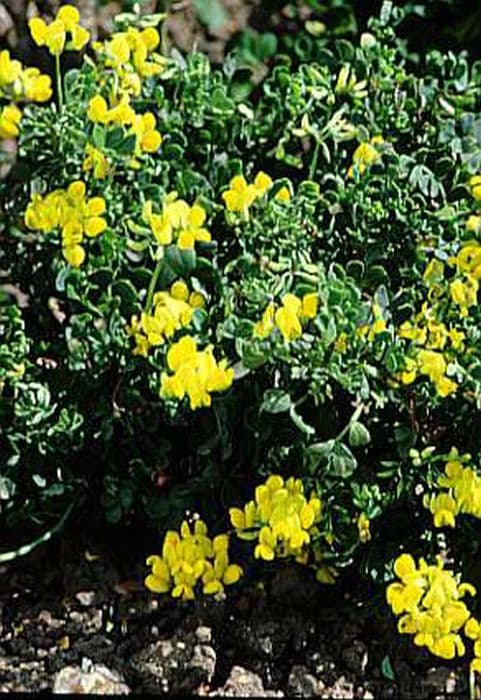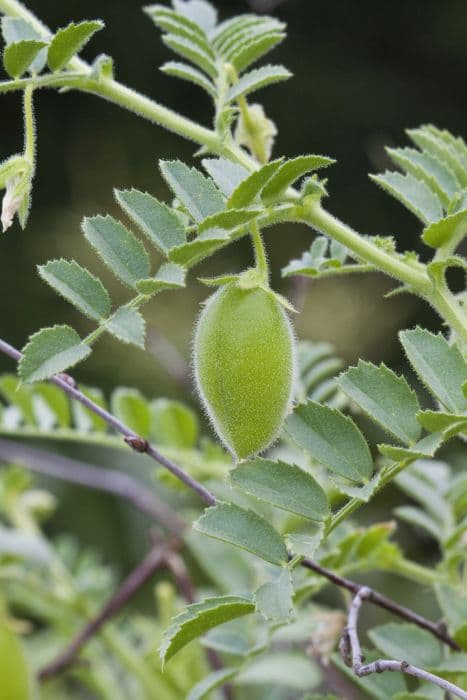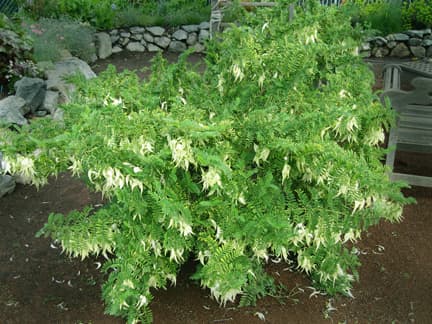Weeping Scotch Laburnum Laburnum alpinum 'Pendulum'

ABOUT
The plant known as the Weeping Scotch Laburnum, or sometimes simply referred to as Weeping Laburnum, bears a striking appearance due to its distinctive cascading branches which give it a dramatic weeping form. The most eye-catching feature of the Weeping Scotch Laburnum is its abundant flowering. In late spring to early summer, it produces long, drooping clusters of bright yellow flowers. These flower clusters, also called racemes, hang elegantly from the branches, creating a spectacular floral display that can be quite a show stopper. The leaves of the Weeping Scotch Laburnum are typically trifoliate, which means each leaf is made up of three leaflets. These leaflets are generally oval or oblong in shape and have a smooth, or slightly hairy texture. The foliage is a fresh, vibrant green which transitions to a more muted yellow in the fall, providing an interesting change in the plant’s color palette. Aside from the flowers, the overall structure and form of the Weeping Scotch Laburnum contribute significantly to its beauty. The branches tend to arch gracefully toward the ground, creating a natural and serene aesthetic often sought after in garden designs. This weeping habit can make the plant an excellent focal point in a landscape. The bark of the Weeping Scotch Laburnum is another notable feature. Generally, it has a textured appearance that can become rugged with age, adding to the character of the plant. With its detailed features and graceful silhouette, the Weeping Scotch Laburnum is both an elegant and dramatic addition to any suitable space where its ornamental value can be showcased.
About this plant
 Names
NamesFamily
Fabaceae.
Synonyms
Alpend Gold Chain Tree, Weeping Scottish Laburnum, Pendulous Alpine Laburnum.
Common names
Laburnum alpinum 'Pendulum'.
 Toxicity
ToxicityTo humans
The plant commonly known as 'Golden Chain' or 'Golden Rain' is highly toxic. All parts of the plant, including the seeds, bark, and leaves, contain a potent toxin known as cytisine, which is similar to nicotine. If ingested, even in small amounts, it can cause severe symptoms including nausea, vomiting, convulsions, and in extreme cases, it can lead to coma or death. It is advised to seek medical attention immediately if any part of the plant is consumed.
To pets
The 'Golden Chain' plant is equally toxic to pets as it is to humans. It contains cytisine, a toxin that affects the nervous system. Symptoms of poisoning in pets can include excessive drooling, nausea, vomiting, diarrhea, abdominal pain, lethargy, convulsions, and respiratory failure, which can be fatal if not treated promptly. Immediate veterinary care is crucial if a pet is suspected of ingesting any part of this plant.
 Characteristics
CharacteristicsLife cycle
Perennials
Foliage type
Deciduous
Color of leaves
Green
Flower color
Yellow
Height
13-16 feet (4-5 meters)
Spread
13-16 feet (4-5 meters)
Plant type
Tree
Hardiness zones
5
Native area
Europe
Benefits
 General Benefits
General Benefits- Ornamental Value: Scottish Laburnum is highly prized for its cascading racemes of pea-like, yellow flowers, which add dramatic visual interest to gardens.
- Shade Provision: Its dense foliage can provide a shaded area in the garden, useful for seating areas or to cool parts of the garden during hot weather.
- Habitat for Wildlife: The flowers attract bees and other pollinators, providing a valuable food source and promoting biodiversity in the garden.
- Seasonal Interest: With its bright flowers in spring and the potential for attractive foliage in autumn, Scottish Laburnum offers multi-season appeal.
- Low Maintenance: Once established, it requires relatively little care, making it a suitable choice for gardeners seeking low-maintenance plants.
- Drought Resistance: It is relatively tolerant of dry conditions once fully grown, making it suitable for regions with sporadic rainfall.
- Soil Adaptability: Scottish Laburnum can adapt to a variety of soil types, although it prefers well-drained soil.
- Compact Size: Its weeping form and controlled growth make it an appropriate choice for smaller gardens or landscapes where space is limited.
 Medical Properties
Medical PropertiesThis plant is not used for medical purposes.
 Air-purifying Qualities
Air-purifying QualitiesThis plant is not specifically known for air purifying qualities.
 Other Uses
Other Uses- Woodworking: The wood of the Scottish Laburnum is dense and can be used for small woodworking projects like turning on a lathe for decorative items.
- Wood Carving: Its fine grain makes it suitable for detailed carving works, often used in creating intricate designs for crafts.
- Instrument Making: Occasionally, the hard and dense wood has been used in the creation of musical instruments such as harps and flutes.
- Ornamental Displays: The attractive, weeping form of the Scottish Laburnum makes it a favorable choice for ornamental garden focal points.
- Photography: The striking yellow flowers provide a picturesque backdrop and are used by photographers to capture natural beauty.
- Education: Schools and botanical gardens might use this plant to teach about toxicology in plants, emphasizing the importance of plant safety.
- Landscape Architecture: The species may be utilized in landscape designs to create natural arches or overhangs in gardens.
- Bonsai: The Scottish Laburnum can be trained into a bonsai form, adding an exotic touch to the art of bonsai cultivation.
- Educational Models: Its branches and inflorescence may be used in botanical models to explain plant structure in educational settings.
- Wildlife Shelter: Despite the toxicity to humans and animals, it can provide nesting sites and shelter for certain bird species.
Interesting Facts
 Feng Shui
Feng ShuiThe Scottish Laburnum is not used in Feng Shui practice.
 Zodiac Sign Compitability
Zodiac Sign CompitabilityThe Scottish Laburnum is not used in astrology practice.
 Plant Symbolism
Plant Symbolism- Warning: Laburnum alpinum 'Pendulum', commonly known as the Scotch laburnum, bears seeds that are extremely toxic if ingested, symbolizing caution and the importance of being wary of hidden dangers.
- Transience: The plant flowers in late spring with beautiful, yet short-lived, yellow blooms, representing the fleeting nature of life or beauty.
- Renewal: Though its leaves fall in the winter, the Scotch laburnum's vibrant return each spring symbolizes rebirth and the cycle of life.
- Beauty: The cascading blooms of the Scotch laburnum are often seen to symbolize natural beauty and grace.
 Water
WaterThe Scottish Laburnum should be watered thoroughly, allowing the soil to dry out between watering sessions. Generally, the tree benefits from 1 inch of water weekly, either through rainfall or manual watering. During the growing season, this could translate to about 1.5 gallons per square yard each week, depending on soil type and weather conditions. Less frequent watering may be necessary in cooler months. Deep, infrequent watering encourages the growth of strong root systems. Always avoid overwatering, as the Scottish Laburnum does not tolerate soggy soil.
 Light
LightScottish Laburnum thrives in full sun to partial shade. It prefers to be positioned where it can receive at least six hours of direct sunlight per day. A spot that is protected from the intense afternoon sun may help prevent scorching of the leaves during the hottest part of the summer, especially in warmer climates.
 Temperature
TemperatureScottish Laburnum can survive in a range of temperatures and is hardy in USDA zones 5 through 7. It can tolerate winter lows down to about -20 degrees Fahrenheit, while summer highs should ideally not exceed 80 degrees Fahrenheit. The ideal temperature for promoting healthy growth generally falls between 60 and 70 degrees Fahrenheit.
 Pruning
PruningPrune the Scottish Laburnum to remove dead, diseased, or damaged branches and to shape the tree, typically after it finishes flowering in late spring or early summer. Pruning allows for better air circulation, light penetration, and can encourage healthy new growth. It's not necessary to prune every year; observe the tree's condition and prune as needed to maintain its overall health and appearance.
 Cleaning
CleaningNot needed
 Soil
SoilScottish Laburnum thrives in well-drained, loamy soil with neutral to slightly acidic pH, around 6.5 to 7.5. A mix with equal parts garden soil, sand, and compost or peat moss creates an ideal growing medium for this plant.
 Repotting
RepottingScottish Laburnum, being a large tree, does not typically undergo repotting as it is usually planted directly in the ground outdoors where it has space to grow.
 Humidity & Misting
Humidity & MistingScottish Laburnum is tolerant of a wide range of humidity levels and does not require specific humidity conditions; it grows well in the natural outdoor environment.
 Suitable locations
Suitable locationsIndoor
Scottish Laburnum is not suited for indoor growing due to its size.
Outdoor
Plant in full sun, well-drained soil, space generously for growth.
Hardiness zone
5-7 USDA
 Life cycle
Life cycleThe life of a Scottish Laburnum 'Pendulum' begins as a seed, typically germinating in moist, well-drained soil during spring. After germination, the seedling emerges and develops into a young plant with a characteristic weeping habit due to its pendulous branches. The juvenile phase transitions to maturity after several years, where the tree produces long chains of yellow flowers in late spring to early summer. Pollination by insects enables the development of seed pods, which mature by late summer and eventually release seeds to perpetuate the cycle. With proper care and favorable conditions, this perennial can live for several decades, going through annual cycles of flowering and dormancy, where it sheds leaves in the winter and enters a rest period until the next spring. Scottish Laburnum 'Pendulum' may also be propagated vegetatively through grafting or cuttings, bypassing the seed stage for faster maturation.
 Propogation
PropogationPropogation time
Spring-Early Summer
The Scottish Laburnum, often known by its botanical name Laburnum alpinum 'Pendulum', can be propagated by semi-hardwood cuttings taken in late summer. To do this, select healthy, semi-ripe wood from the current year's growth and cut a length of about 6 to 8 inches (15 to 20 cm). The lower leaves should be removed and the cut end can be dipped in rooting hormone to encourage root development. The cutting should then be planted in a well-draining potting mix. It's important to keep the cutting moist and in a warm spot with indirect sunlight until roots develop, after which it can be slowly acclimatized to outdoor conditions. This method tends to be the most popular as it helps to maintain the desirable weeping characteristics of the cultivar which might not be reliably transferred through seed propagation.




![Kowhai [Sun King]](/_next/image?url=https%3A%2F%2Fplants-admin.emdemapps.com%2Fimages%2Fplants%2F%2Fimages%2F604b57cb7f598.png&w=640&q=75)




